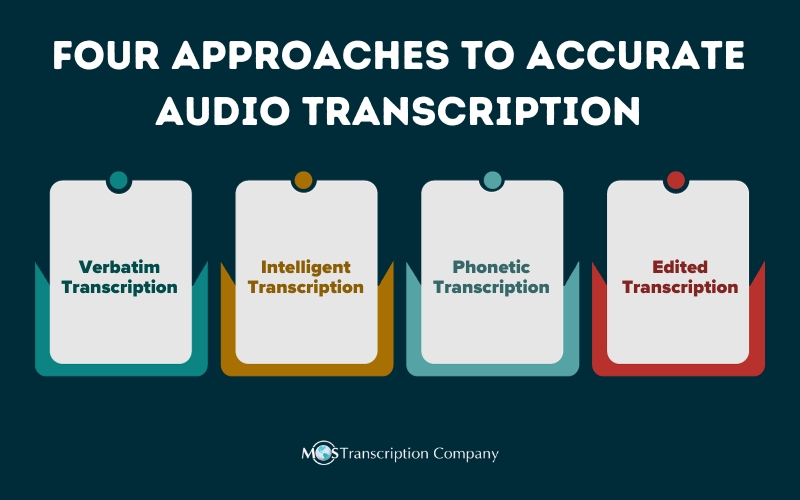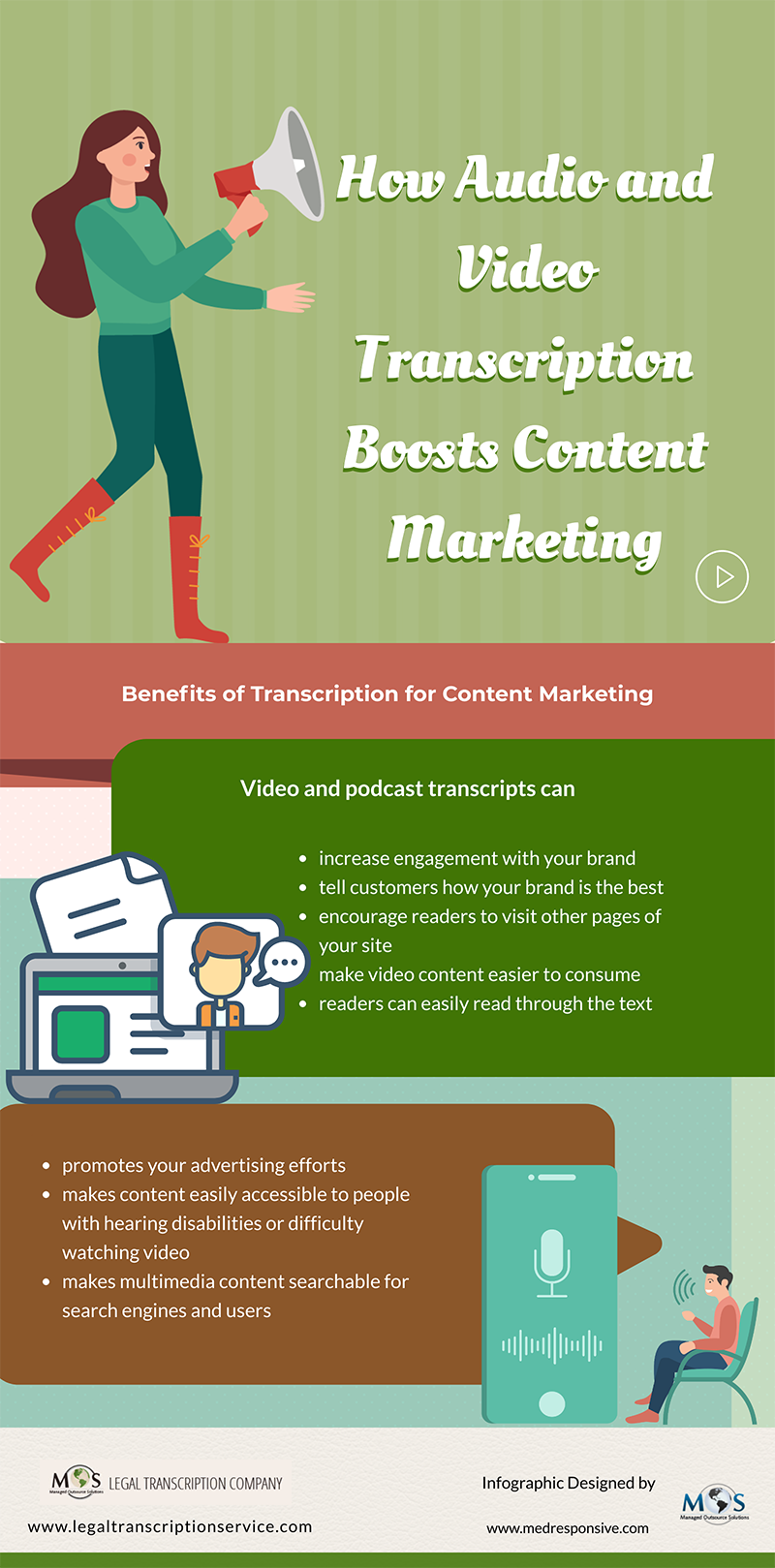Businesses use various types of content such as video, audio, podcasts, and narrated slideshows to boost their online presence and reach their targeted audience. Accurate transcripts play a key role in improving accessibility to such content. Search engines cannot crawl audio or video content directly, but they can crawl the text. Transcripts are important to make your content searchable. Today, many businesses rely on audio transcription services for audio and video transcripts. A reliable transcription company will ensure accurate, properly edited transcripts of videos or podcasts with correct text and speaker transitions.
Importance of Audio Transcription
Audio transcription generates a text record of important events and also provides machine-readable information for dissemination on the internet. With audio transcription, any audio material can be transcribed into a text document and made available to users. Audio transcription greatly helps individuals with hearing impairments. Today, businesses rely on audio transcription services to document, back up and archive recordings of important events and activities. Transcription services are widely used by industries like media, law, IT, healthcare, construction, academics, entertainment etc.
Four Ways of Transcribing Audio
- Verbatim Transcription: Verbatim transcription, also known as true verbatim transcription, includes all filler words, pauses and non-verbal communication. It involves transcribing each and every word uttered by the speaker, which makes it long and very detailed. If there is more than one speaker, then the transcriptionist may mark interruptions, conversational affirmations like “right”, “uh”, “hm” and other overlapping conversations. Verbatim transcripts also include laughter and background noises, but do not include noises that are irrelevant to the transcript like thunder, police sirens and other external noises.
- Intelligent Transcription: Intelligent verbatim transcription converts audio into concise, readable text. In this method, the transcriptionist has the freedom to edit and discard parts of speech. Instead of transcribing the speech exactly as in the audio, intelligent transcription focuses on communicating the meaning of the audio content in the most natural way by removing unnecessary elements like repeated words or phrases and ensuring grammatical restructuring. This results in a clear, neat transcript that communicates the content properly. Intelligent transcription does not include filler words, repetitions, off-topic content, etc.
- Phonetic Transcription: This is a form of transcription that is different from any other type of audio transcription. It captures the way the speaker utters a sound and focuses mainly on the pronunciation of words. This also extends to annotation of the way that the speaker’s tone rises and falls and how different sounds overlap within the audio. It does not include noises that interrupt with the transcript. This type of transcription requires a specialized notation system and needs to be done properly.
- Edited Transcription: This is also known as clean verbatim transcription. It aims at preserving the meaning of the text as it is. It will not paraphrase the text or change its meaning in any way, and does not capture the way that the speaker communicates. It excludes stammering, filler words and other non-verbal communication. It provides an edited version of the content that ensures completeness and readability.
Explore the advantages of transcription for content marketing in this insightful infographic
Nine Ways of Using Video and Audio Transcription for Content Marketing
- Podcasting: The popularity of podcasts is soaring and millions of listeners are tuning into podcasts on a regular basis on smartphones, mobile devices, and in-dash entertainment systems. According to a new Buzzsprouts survey, podcasting has reached the highest numbers ever, with 90 million Americans being weekly podcast listeners. Creating a podcast related to your industry or niche can be a great way to showcase your expertise and provide valuable insights and information. Podcasts can be used to conduct interviews, offer tips and advice, share stories, and promote your products or services. Podcasting can help you position yourself as an industry expert, reach prospects, build a following and grow your business. For maximum exposure, be sure to promote your podcast on your website, social media, and other marketing channels to reach a wider audience. Podcast transcription can enhance accessibility of the content.
- Audiobooks: Audiobooks are another powerful way to engage with your audience and promote your business. They are ideal to reach people who consume content on the go. Audiobooks can be used to educate your customers about your products or services or to entertain them. If you have published a book or have valuable content that can be converted into an audiobook, you can make it available on platforms such as Audible or iTunes and generate additional revenue for your business.
- Webinars and Webcasts: Hosting live webinars and webcasts or uploading pre-recorded audio content on platforms like Zoom, GoToWebinar, or YouTube Live is an ideal way to get complex messages across to your audience. While webinars are interactive seminars, lectures, workshops or product and service demos presented to audiences of fewer than 1,000 people, webcasts are similar to traditional TV broadcasts and streamed to audiences of up to 50,000. These options can be used to educate your audience, provide valuable information, and promote your products or services.
- Audio Ads: Audio ads are another effective marketing strategy to reach your target audience on platforms such as streaming services, podcasts, or internet radio. Statista predicted that ad spending in the digital audio advertising segment will reach US$10.14bn in 2023.The advantage of audio ads is that they allow you to reach listeners in the moment they are most receptive. You can promote your products and services to your audience when they are actively engaged with audio content, which can increase brand awareness and drive conversions.
- Audio Testimonials and Reviews: Audio testimonials and reviews are a powerful marketing tool to build trust and credibility with potential customers. You need to first collect high-quality audio testimonials and reviews from satisfied customers. Encourage them to provide details about the results they achieved or the problems they solved. Next, use the most impactful and authentic audio testimonials and reviews in your marketing channels such as your website, social media, or in your marketing campaigns to showcase the positive experiences of your customers and encourage others to do business with you. Tracking metrics such as website traffic, engagement, conversions, and customer feedback can help you understand how audio testimonials and reviews are working to impact customer decisions and improve business outcomes.
- Audio Content for Social Media: Create engaging content and share it in various ways on social media platforms such as Instagram, Facebook, and Twitter. You can share short audio clips, and sound bites, snippets from your podcasts, webinars, and other audio content on social media and engage with your audience. Make sure to choose the audio content option that aligns with your brand and resonates with your target audience. Also, make sure that your audio content is optimized for social media platforms. For example, create short and engaging snippets for Instagram Stories, TikTok, or Twitter that meet the platform’s specific requirements for audio clips. Adding visually appealing graphics, captions, or animations to complement your audio content can make it more shareable. When you use audio content for your social media campaign, ensure you’re doing so in a safe manner without copyright infringement.
- Voiceovers: Including professional voiceovers in your marketing videos, animations, explainer videos, and other visual content is another effective way to use audio content to engage your audience. A well-crafted, customized voiceover can convey your brand message clearly and build rapport with potential clients.
- Branded Audio Content: Branded audio content includes jingles, sound logos, or audio mnemonics representing your brand. Create effective branded audio content that aligns with the brand’s identity, values, and messaging, and resonates with your target audience. Such content can be used across various marketing channels including social media, websites, advertisements, events, and other digital or offline platforms. A distinctive audio element can reinforce your company’s brand identity in the minds of the target audience and help it stand out in a competitive market.
- Interactive Voice Response (IVR) Systems: IBM defines an interactive voice response (IVR) as an automated telephone system that combines pre-recorded messages or text-to-speech technology with a dual-tone multi-frequency (DTMF) interface to engage callers, allowing them to provide and access information without a live agent. This system uses audio prompts and responses to guide callers through a series of options and can provide a seamless and personalized experience for your customers, saving time and improving satisfaction.
Boost your content marketing strategy with transcription and engage your audience effectively.
When using audio content in your marketing, transcription is important to improve accessibility and to promote SEO optimization, content repurposing, shareability, accuracy and clarity, brand consistency, and audience engagement. Partnering with an experienced audio transcription company can ensure accurate and timely transcripts for podcasts, audiobooks, webinars, and all other types of audio content.


